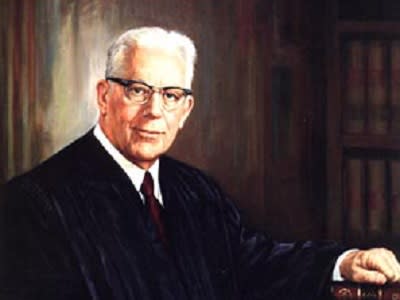Politicians as Supreme Court Justices? Not common in recent years
Over the weekend, President Barack Obama said in an interview that he probably wouldn’t be interested in becoming a Justice after his term ends. And in terms of recent trends, it’s been a while since a major national political figure joined the Supreme Court.
Earl Warren
President Barack Obama sat down with Jeffrey Toobin for a New Yorker interview and the former president of the Harvard Law Review was asked the “Taft Question” by Toobin. As you’ll recall, William Howard Taft was the one, and the only, President to later serve on the Supreme Court.
“When I got out of law school, I chose not to clerk,” President Obama said. “Partly because I was an older student, but partly because I don’t think I have the temperament to sit in a chamber and write opinions.” While Toobin said Obama seemed “tempted” by the idea, the current President also said, “I think being a Justice is a little bit too monastic for me. Particularly after having spent six years and what will be eight years in this bubble, I think I need to get outside a little bit more.”
There’s nothing in the Constitution to prevent a former President from serving in a different branch of the federal government. President Warren Harding nominated Taft in 1921 as Chief Justice nearly a decade after Taft left the White House. And John Quincy Adams went on to a distinguished career in the House of Representatives after leaving the presidency.
President Obama would face some major hurdles if he ever changed his mind about a career on the bench, and especially the high court, after 2016.
First, any Supreme Court nominee needs to go through the grueling public testimony process, and she or he must approved by a majority of the Senate. In the past, most Supreme Court Justices were approved by a near unanimous voice vote; in the modern era, the vote often goes along party lines in the Senate. The sight of a former President testifying before the Senate would be very interesting, on a number of levels.
Then there is the argument about President Obama’s legal background. As President Obama noted in the New Yorker interview, he decided not to clerk coming out of Harvard. He worked as a lawyer on civil rights cases in Chicago and he lectured on the law at the University of Chicago; however, much of his professional career has been in politics.
The argument can be made that a former President with eight years of experience dealing with the Supreme Court and the Justice Department has a unique insight into broader legal issues. But any parallels between Obama and Taft in this area are few and far between.
Taft’s career goal was to be on the Supreme Court and not become elected as the President of the United States. Taft had a prominent legal career at a young age, and he was the youngest Solicitor General in history. Taft also turned down offers from two Presidents, William McKinley and Theodore Roosevelt, to have his name placed in nomination for the Supreme Court , years before he became President himself.
Taft was also very vocal about saying little good about the White House after he lost the 1912 election to Woodrow Wilson. “I don’t remember that I ever was President,” Taft said in later years.
Since the World War II era, the last major elected political figure to receive a Supreme Court nomination was Earl Warren, who was the governor of California and the GOP vice presidential candidate in 1948. Warren spent a brief time in private legal practice before switching to a very prominent public career as a district attorney and as California’s attorney general.
President Dwight Eisenhower nominated Warren to become Chief Justice in 1954 and he was approved by a voice vote by the Senate.
Another significant political figure to join the Supreme Court was Charles Evans Hughes. He graduated second in his class from Brown University at the age of 19, and he held a series of positions in private practice, as a law professor, as a state attorney and as governor of New York – before President Taft appointed Hughes to the Supreme Court in 1910.
Hughes then quit the Supreme Court to oppose his former teaching compatriot at New York University, Woodrow Wilson, in the 1916 presidential election. Hughes narrowly lost the election to Wilson, and he later served as Secretary of State before Herbert Hoover nominated Hughes for a second term on the Supreme Court in 1930.
In his distinguished public career, Hughes’ time in elected office consisted of his time between 1907 and 1910 as New York’s governor and his 1916 campaign for the presidency.
Prior to Warren, there were several Supreme Court nominees who came directly from political careers to the court. George Sutherland, James F. Byrnes, Harold Burton, and Hugo Black all came from the Senate in the period between Hughes and Warren.
Today, a look at the nine current Justices shows that some experience in the court system at a federal level is almost a prerequisite for a nomination. Eight of the nine current Justices served in the U.S. federal appeals court system. The exception is Elena Kagan, who clerked for Thurgood Marshall and was the dean of Harvard’s Law School before becoming Solicitor General.
Experience as an elected political figure doesn’t seem to be on the Supreme Court resume.
Scott Bomboy is the editor in chief of the National Constitution Center.
Recent Historic Stories
Remembering the other important Lincoln in American history
Why Columbus Day isn’t really a national holiday
Forgotten facts about George Washington’s private life
10 fascinating facts about Grover Cleveland, the only double President


